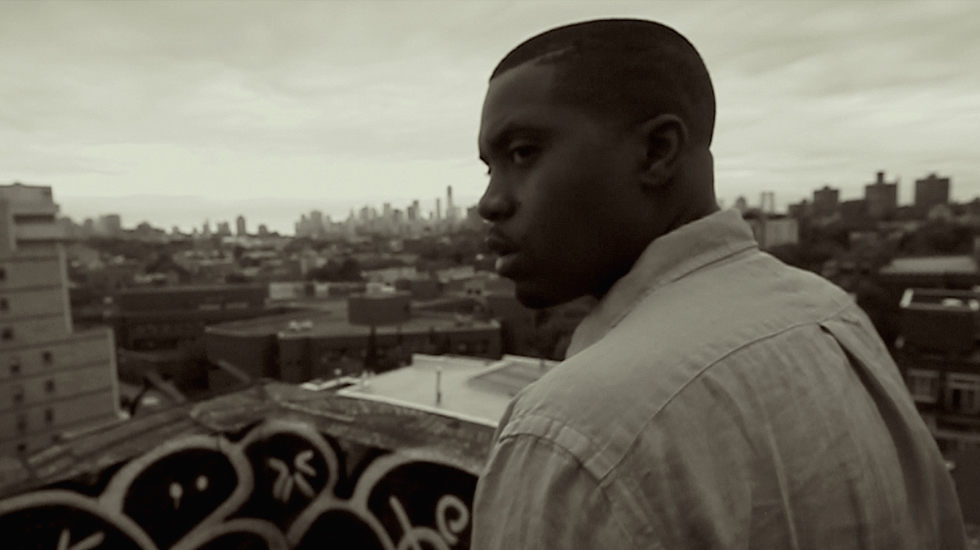One Nas

Hip-hop began as poetry, and a good hip-hop documentary will you remind you that poetry is still at its core: bigger than the beats, bigger than nostalgia for another decade. Time is Illmatic, the debut documentary from multimedia artist One9 and journalist Erik Parker, presents Nas the prophetical poet. Reflecting on the release of his first album, 1994’s Illmatic, the rapper’s family, childhood friends, early producers, and rap contemporaries pinpoint exact lyrics that illustrate why Nas mattered. Often cited is Nas’ self-proclaimed loss of innocence, “When I was 12 I went to hell for snuffin’ Jesus,” on Main Source’s “Live at the Barbeque,” and the opening stanza of “One Love,” his poignant letter to an incarcerated friend: “What up kid? I know shit is rough doing your bid… No time for looking back when it’s done / Plus, congratulations, you know you got a son / I heard he looks like ya, why don’t your lady write ya?”
Time is Illmatic is not a career-encompassing documentary. It touches on Nas’ present, his involvement with the Hip-hop Archive and Research Institute at Harvard, his two children he uncannily predicted in “The World is Yours” with the line: “To name my daughter, my strength, my son, the star, will be my resurrection.” But it retains its focus on the creation of Nas the public entity and the patron saint of the housing projects he grew up in, Queensbridge.
Last Wednesday, Time is Ilmatic opened the Tribeca Film Festival in New York. We spoke with director One9 about choosing the subject of his debut feature.
EMMA BROWN: How did you first get into filmmaking? Can you tell me a little bit about your background in the arts?
ONE9: I grew up in the D.C. area as a street artist, graffiti artist, when I was 12, 13. [I was] just engulfed in the culture. Eventually, I moved on to doing murals and then got a job teaching kids in the arts—teaching them murals and bringing them to colleges to learn design. I learned a little bit of camerawork and production just through working in TV, and was able to get into film through meeting some different folks and doing experimental shorts and things like that.
BROWN: What drew you to Nas and Illmatic?
ONE9: Growing up, I listened to a lot of hip-hop, jazz, rock, and blues. But when I first heard Illmatic, I knew that it was something that was truly unique and special. The album hit me in so many different ways. I was listening to it with a bunch of friends and we just played it over and over and over again. I used to play it when I painted, so it connected to me on a visual level. Erik [Parker] was doing a 10-year anniversary story for Vibe magazine on Illmatic, and he asked me, “Would you be interested in shooting some video?” We went over to Nas’ father’s house, Olu Dara. The interview was three hours, and we left with a much better understanding of what Nas’ life was like, but also the importance of the culture, the family legacy, the music legacy, and all the different conditions that the family went through growing up. After that point, we realized, this is much bigger than a music documentary—it’s something that you want to make into a full-length film that spans generations and really talks about the issues that the family faced.
BROWN: When you decided that you wanted to make a full-length feature, was Nas totally on board, or did you have to convince him?
ONE9: When we first presented it to Nas, we had cut a trailer with interviews we’d done before with his father and a lot of the producers from Illmatic—Pete Rock, DJ Premier, Faith Newman. We cut a rough trailer and sat down with him, and he was intrigued, but he wasn’t fully committed yet. He was like, “Keep going, let me see what you can do.” So we just kept going. We did it out of pocket and we sent an updated trailer around to friends and it eventually got to the Ford Foundation, who really took a chance on us. It was their social justice program called JustFilms and Orlando Bagwell, the director at the time, gave us a research grant. At that point twe called Nas back up and we said, “We have something to work with and we would love to continue this film.” We shot some more footage and showed it to him. He looked at it and said, “This is amazing. I want to help you guys—whatever you need to finish. As many interviews as you need to do.” So we moved forward. Nas was very private, very guarded initially. As we kept going and showing him different scenes and clips, he really opened up and understood that we are artists ourselves, we come from hip-hop as a background and really connected with him on so many different levels.
BROWN: In the documentary, Nas takes us on a tour of Queensbridge. Was that footage you shot specifically for the film, or did it already exist?
ONE9: There are a few instances. There’s one in 1996, when he’s walking around, which is archive footage we found. The footage of him going back towards the end of the film is footage that we shot ourselves last summer. It was so great to get him to go back to a community that really means so much to him—it’s part of his whole essence, his life. He represents that neighborhood to the fullest. He says he can walk through there at any time without any bodyguards; people love him. There’s a love for what he is—not just the music, but for how he carries himself. He’s an inspiration for those around him.
BROWN: It’s interesting that the neighborhood still feels such a strong connection to him. It’s been 20 years since he left, and the teenagers living their now weren’t even born when Illmatic came out.
ONE9: Right. It’s a testament to someone who really stood for representing himself in a way that’s true and honest—to his community, to his family, to hip-hop.
BROWN: Do you have a favorite Nas lyric?
ONE9: There isn’t any one particular lyric, it’s really a whole song: “One Love.” The way he was able to write a story about people who were locked up and really visually capture the feeling of what it was like for people that don’t have access to the world anymore. That song really captured that essence of what, to me, Illmatic is about. But there are so many lines; that whole album is timeless. It’s almost like looking at a painting and saying, “What color do you like the best?” When you add it all up together, it’s a true masterpiece.
BROWN: The film briefly touches on the history of Queensbridge, and how the housing project was affected by the crack epidemic and “white flight.” Do you—or does Nas—feel like it’s changed significantly since 1994?
ONE9: I think Nas feels like the conditions may have worsened. You look at the issues now, and school systems have a higher dropout rate; prison systems are even more full. A lot of those conditions exist on such a terrifying scale that we feel like the film is so important now to address those issues. One of our goals now is to put the film into school systems; our producer Martha Diaz is working with the Department of Education to put the film into high schools as well as college curriculums. Tribeca has a system that they’re working with on Riker’s Island—a prison system—to get the film viewed there as well.
BROWN: Do you think there are any rappers who are Nas’ equivalent today—who will be equally significant in 20 years?
ONE9: It’s difficult to say “equivalent.” There are definitely people who are inspired by Illmatic who are making their own versions—Kendrick Lamar speaks very highly of Illmatic; J. Cole actually has a song dedicated to Nas. Those are a few voices that I feel, in their own right, will create their own language that represents a time. They are now carrying the torch for a new generation.
BROWN: Did you watch other recent rap documentaries, such as Michael Rapaport’s A Tribe Called Quest documentary Beats, Rhymes, & Life (2011), before you started filming?
ONE9: I did watch the Quest doc. I watched a lot of movies. One of the films that inspired me was Hoop Dreams (1994), a documentary that came out many years ago [that is] a survival story through basketball. Style Wars (1983), a documentary on early hip-hop and graffiti pioneers, also inspired me. I looked back at The Battle of Algiers (1966)—an incredible, incredible film. It’s not a doc, but it’s a really hard look at reality. I looked at a lot of different stories—from The Godfather (1972) to Martin Scorsese’s films like Taxi Driver (1976) and Raging Bull (1980)—films that really connected with what was going on in a community. In certain films you identify with the character, but you really want to know more about the essence of what the culture was like, what the neighborhood was like, what was going on with the day-to-day lives. Those are the films that inspired me most.
BROWN: One of the moments that really struck me in the film is when Nas’ brother, Jungle, remembers witnessing their childhood friend get shot, and then having to walk by that place every day.
ONE9: It was so important to add Jungle, who gives a different perspective, to the film. Those events affected both Nas and Jungle—they were traumatized. Their best friend and neighbor growing up for all those years was killed. Just imagine the psychology of what went on in their lives the day after, the weeks after, the months after. I think having Jungle say that on camera now is so therapeutic. He came up to us after the film and said, “I needed this. Thank you so much. It really meant to me, my brother, and my family.” So I really felt a connection—not just as a filmmaker, but really putting something out there that can help someone’s life change. I’m hoping that’s what the film does.
TIME IS ILLMATIC IS CURRENTLY SCREENING AT THE TRIBECA FILM FESTIVAL.






